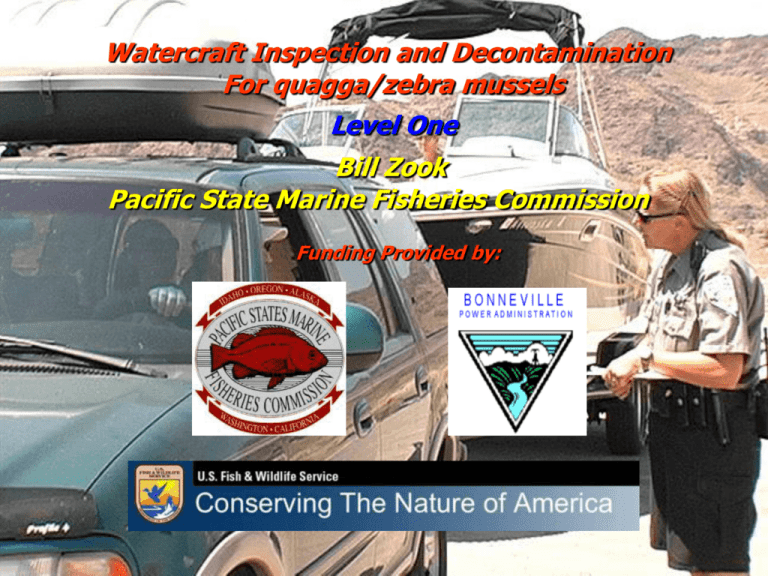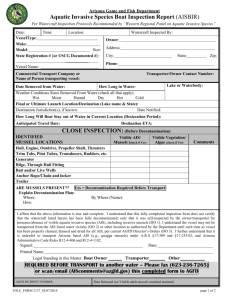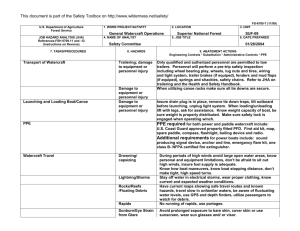Planning For Lewis and Clark Zebra Mussel Exclusion in the
advertisement

Watercraft Inspection and Decontamination For quagga/zebra mussels Level One Bill Zook Pacific State Marine Fisheries Commission Funding Provided by: Today's Drill (about 5 Hours) Zebra/Quagga Mussel Educational Video (30 Minutes) “The Big Picture” Q and A - Biology, Distribution, Impacts and Transport Vectors, etc. Break Watercraft Inspection and Decontamination Video (20 Minutes) Uniform Minimum Protocols and Standards (UMPS) for Watercraft Interception Programs in the Western US Q and A – Watercraft Inspection and Decontamination Lunch Break Schedule Continued The Local Perspective Insert name and affiliation of person making presentation here “Hands-on” Watercraft Inspection Exercise (30 Minutes) Review List, Written Exam, Course Evaluation and Certification Now .... Zebra/Quagga Mussel Educational Video (Copies available) Two Distinct Parts Part 1 – General Information Background (Biology, origins, distribution, vectors) Impacts (Through the eyes of those affected) Call to action (What you can and should do to prevent their spread) Later …. Part 2 – Watercraft Inspection and Decontamination Training Show Part 1 of Don’t Move a Mussel Video here Summary of Key Points Made in Video .... The stakes are extremely high – in the 100’s of Millions of dollars to your state and local economy - and even more in unquantifiable impacts to natural resources and life style Damages last forever … agriculture, water supply, recreation, power production, ecology, etc. Everyone stands to lose – traditional competitors for limited water resources are on the same team this time – more opportunity for cooperation and political action Prevention is the best hope – eradication is not a practical option and mitigation is extremely expensive Prevention/containment are possible!!! - Minnesota example Education and outreach, watercraft intervention, detection monitoring and contingency planning are key weapons to preventing dreissenid mussel expansion Questions on the video or anything covered so far? The Bigger Picture! Watercraft interception is not the only game in town, other measures, particularly public outreach and education, are critical to successful prevention/containment program. Zebra/Quagga Mussel Prevention Can’t be Done in Isolation But, you’re not alone in this effort !!!!!! National Public Education and Outreach Nationwide benefit us all Federal Legislation, Funding, Programs and Organization Regional Basin-wide Coordination and Communication Protects Neighbors Common Databases, Protocols, Monitoring, Response Planning Local Strong State Legislation, Funding, Education/Outreach and Early Detection Monitoring Local Government and User Group Involvement ANS Prevention in the US (Organizational Framework) National Invasive Species Act of 1996 (NISA) – National Program for ANS Prevention, Monitoring and Research – Zebra Mussel Inspired ANS Task Force – Intergovernmental Organization co-chaired by USFWS and NOAA to implement NISA Quagga-Zebra Mussel Action Plan Western Regional Panel (1 of 6) – Established by the ANS Task Force to coordinate NISA activities in the western U. S. including those identified in the 100th Meridian Initiative (a section of NISA) o 100th Meridian Initiative – 19Western States – 6 Basin Teams (Colorado, Columbia, Mississippi, Missouri, Arkansas and Tahoe Basin Teams) • Individual State ANS Organization and Plans Your state is an active participant at every level Some Examples of Programs Already Working for You National Awareness Campaign - Internet, Visitor Information Centers, News Media, User Group Publications, Outdoor Shows, PSA’s, SAH. Traveler Information Radio Systems (TIS) and Billboards Outreach Partnerships with Water-Dependant Businesses – Marinas, Marine Supply and Repair, Tackle Shops, Etc. Missouri, Columbia and Colorado Basins More Programs Without Borders .... Access Area Signage • • • New Uniform ANS Ramp Sign Available Brand recognition demonstrates cooperation and coordination Doubled # of Access Areas Signed in the Western US Since 04 Training - Boating Law Enforcement Personnel - Commercial Boat Haulers Incident Responders Water Users Marina Operators More Programs Without Borders .... Boater Survey Program • • • Standard Survey of Boaters - Throughout the West Common Database Maintained by USFWS Over 30,000 Records from 28 States Veliger/Substrate Monitoring Program • • Program, Processing and Database Maintained at PSU Serves all Western US States Rapid Response/Containment Planning • • • Lower Colorado Basin Plan (Regional) Columbia Basin Plan (Regional) Individual State Plans Lake Mead Boater Survey Data 100th Meridian Website (100th Meridian.org) Enforcement Authority Summary A Couple More Things.... Subscribe to the National News Website List serve for the latest news and information about what’s going on the Lower Colorado, California and the rest of North America and the world with quagga/zebra mussels and other ANS protectyourwaters.net New WIT Website available January 1, 2010 –Training resources, updates, pictures, forms, supplies, equipment, etc aquaticnuisance.org Level Two (Train the Trainer) training offered periodically at Lake Mead – two-day intensive, hands-on inspecting and decontaminating watercraft – NO COST (except travel) Next Level Two’s – Check WIT website and add here Any Questions on anything we’ve covered so far??? 10 minute Break And Then…. Part Two – Inspection and Decontamination Video Show Part 2 of Don’t Move a Mussel video here Key points about inspection and decontamination .... From Part 2 of video Large slipped watercraft/equipment most likely to have settled adult or juvenile mussels attached Day-use boats more likely to have veligers in standing water, cooling system, equipment, etc. Under the right conditions, it is possible for day-use watercraft to have tiny attached mussels - w/i hours Trailers are most likely to have loose mussels that have been scrapped-off the watercraft/equipment upon loading or veligers in water pockets – light brackets, hollow frame members, etc. Yes, 104 degree water will kill veligers, but adult mussels require 140+ degree water or prolonged exposure Questions? Uniform Minimum Protocols and Standards for Watercraft Interception Programs for Dreissenid Mussels in the Western United States “UMPS” Adopted in September 2009 by the: Western Regional Panel Aquatic Nuisance Species Task Force and it’s Member Agencies Bill Zook and Stephen Phillips Pacific States Marine Fisheries Commission Hundreds of contributors from over 70 western agencies/organizations Why uniform protocols and standards? Neither mussels nor boaters recognize jurisdictional boundaries Need to encourage and support the implementation of the most effective region-wide interception strategies - Your program is only as good as your neighbors Increase effectiveness by ensuring everyone uses the best available science and technology Maximize efficiency and use of limited resources by building trust in and between programs Make programs more consistent to reinforce the prevention message with boaters, the public , law makers and policy makers Make it easier for the boating public to understand, anticipate and comply with “clean boating” principles Q-ZAP recognizes as one of it’s highest priority action items “the development of consistent inspection and decontamination protocols” Watercraft Interception Programs in the West UMPS began with: An On-line Survey of WIP Programs in 20 Western States (Jan-Feb, 2009) Identified 72 programs in 20 western states (28 CA) 300+ waters At least one (sometimes minimal) program in each state On-line survey sent to all - 46 questions to define program parameters and gauge support for UMPS 96% return rate Programs range from spot-checks to full-meal deal Report now available Raw survey results also available (see me for link) Some Interesting Survey Findings … Total of 138 full-time, 110 part-time and 0ver 300 seasonal FTE’s 72% of programs received their training directly from WIT L1 or L2 Course 58% exclude all watercraft that are not clean, drained and dry 52% offer decontamination services, of those 54% also require a “drying” period following decontamination 52% certify watercraft, of those 54% use “banding” method of certification, many with paper receipt 60% do not accept another agency/organization certification (only 3% unconditionally) 90% recognized the benefit of having Uniform Minimum Protocols Standards UMPS Report Recommendations for: Program levels – Recognizes vast differences in individual agency/organization “capacity” e.g. authority, resources, political and public support, etc. Protocols and Standards for: Screening interviews – Standardize questions Inspection – When, where and “how to“ for various watercraft/equipment types and conditions Decontamination – Equipment, protocols and standards Quarantine – Calculations, options and qualifiers (ballast) Exclusion – Last resort option where other, more userfriendly options, aren’t available Certification - When, where, how and cross-jurisdictional coordination Program Levels Level 1 – Self Inspection Programs (mandatory/voluntary) Low risk waters where implementation "capacity” is limited (Capacity = funding, authority, access control, political will) Pro’s • Low cost • Excellent public education tool • Better than nothing – good starting point Con’s • Minimal protection – compliance not guaranteed Currently implemented on 100+ secondary risk waters in Utah (mandatory) and under consideration in Missouri and South Dakota Level 2 – Screening out high risk watercraft Screening interview and limited inspection but no comprehensive inspection or decontamination services provided Pro’s • Prevents the launch of any watercraft/equipment that are not clean, drained, dry or have been used in any mussel positive state/area (High Risk) • Relatively inexpensive to implement Con’s • Not boater/recreation friendly • Can result in local economic hardship Many of the water districts in California, selected waters in Kansas, North Dakota Level 3 – Comprehensive interception program High risk waters and wherever possible; includes screening, inspection, decontamination, quarantine and possible certification Pro’s • Offers high level of protection limited only by effectiveness of decontamination/quarantine protocols and standards used • Preserves recreational and economic values • Offers best opportunity for cross-jurisdictional cooperation Con’s • Expensive, labor intensive and requires strong political commitment Lake Powell, Lake Mead, Lake Tahoe, Major waters in the states of California, Washington, Colorado, Idaho, Utah Screening Interviews – Step 1 Prior to launch at point of entry/access –To assess the level of risk (in order to concentrate efforts on high risk watercraft) • Determine the recent use history – Use standard form Home location of owner/operator Specific location (waterbody) of last use The date of last use How the watercraft has been maintained since (Clean, drained & dry? Decontaminated who/when? ) Verify responses with visual keys (license plate, condition) • Watercraft/equipment that are not clean, drained, dried or with ballast tanks should be subjected to comprehensive inspection or excluded • Watercraft/equipment coming directly from mussel positive waters within last 30 days should be subjected to comprehensive inspection or excluded Watercraft/Equipment Inspection • If you don’t have specific authority, get owner/operators permission first Adopt and use a checklist of watercraft parts/areas to guide inspection Include trailer, propulsion system and accessories Be systematic; starting at point “A” and ending at point “B” to assure complete coverage Use the inspection as an opportunity to educate the owner/operator • If attached mussels (dead or alive) , standing/trapped water or attached vegetation (including algae accumulation) are found, require decontamination, quarantine (combination) or exclude • Watercraft/equipment that have been successfully decontaminated or quarantined (dried) for the required time or that are clean, drained and dry and have not been launched in mussel positive waters/areas in the past 30 days should be allowed to launch (except w/ballast tanks or inaccessible raw water storage tanks) Watercraft/Equipment Decontamination • Get the permission of the watercraft owner before doing decontamination • Away from the water where water and solids can be contained • Strongly consider total containment/ treatment option – low cost systems available • Be systematic and thorough including all parts/areas and accessories Standards: Hot water pressure washer set to achieve 140 F at point of contact Maintain contact for at least 10 sec. (leading to trailing edge) on all exposed surfaces Pressure washer capable of min. 4 gpm at 3,000 psi Use Pressure washer attachments for flushing sensitive areas and cooling system, live/bait wells, storage compartments, accessories, etc. Drain then treat (hot water) all areas of standing, trapped, stored water (Ballast Tanks require special attention) Maintain 60 sec. contact time for hard to access areas Monitor temperatures carefully and often Consider adding period of quarantine/drying following decon – insurance policy Quarantine/Drying • Time out of the water exposed to air temps leads to mussel desiccation Varies depending on temperature and humidity - from 1-30 days Higher the temps and lower the humidity = shorter the drying time and visa versa Use 100th Meridian calculator or UMPS guideline or the alternative below Maximum daily temperature Degrees Fahrenheit Minimum days out of water < 30 30- 40 40-60 60-80 80-100 >100 3 28 21 14 7 3 • Mussel removal still required after drying! • Quarantine/drying standards do not apply to watercraft with ballast tanks! Watercraft/Equipment Exclusion • Exclusion is the only remaining option under some conditions When decontamination/quarantine facilities are not available When the owner/operator declines other measures Standards: Watercraft or equipment that are coming from known zebra/quagga mussel areas in the last 30 days that have not been decontaminated and/or been out of the water for the required time should be decontaminated if approved facilities are available; placed in self or on-site quarantine for the required time frame; or excluded. Watercraft or equipment that are not clean (having attached vegetation, debris or surface deposits that can mask the presence of small mussels), drained (no visible water in any live well, bait well, bilge area, engine compartment, floor or cooler) and dry (no standing water in boat, equipment, trailer, engine) should be decontaminated and/or quarantined or excluded. Watercraft Certification/Banding • About half of 70 agencies/organizations in the west now offer some form of certification following inspection, decontamination or quarantine Streamlines the process for repeat users and for overworked staff Banding is the preferred and recommended method of certification Mostly used on local basis only; goal is to use across jurisdictions Certification signifies that “best practices” (UMPS) have been applied to inspect, quarantine and decontaminate, not that it’s “mussel free” Banding Variety of banding materials used - share common traits: Connects the watercraft/equipment to the transport vehicle (trailer) Tamper resistant material (wire, Kevlar, Mylar, plastic strapping, etc.) Certification is considered “invalid” if the band has been severed or tampered-with Contains the name of agency/organization, contact information for verification and date and time of application (paper receipt) Can only be applied by trained personnel And finally …… These Considerations: Living document subject to periodic and systematic updating “Minimum” protocols and standards, more restrictive options discretionary Recognizes the need for additional peer reviewed research on the effectiveness of currently recommended protocols and standards for watercraft decontamination – In the works (UNLV) Addresses the wide range of “capacity” currently available to the many different implementing agencies/organizations Includes the contributions, comments and edits of more than 100 “experts” Both the Watercraft Survey and Uniform Minimum Protocols and Standards reports available at : http://www.aquaticnuisance.org/wit Questions? Lunch Break! The Local Perspective What does all this mean for me and how do I apply what I’ve learned today on my water(s) here in State, Region or Agency/Organization? Name and affiliation of person presenting Local Perspective Local perspective presentation here Your turn .... Inspection Exercise – 40% of grade Unfortunately, no decontamination exercise at Level One Group of 10-12 assigned to a specific watercraft – stick to that watercraft, circle that number and print your name on the form Have a plan! Watercraft , trailer, equipment have been “seeded” with between 20-40 “fake“ mussels for you to find Please work independently – 25 minutes to complete the exercise We’ll be out there to answer questions – refer to the back of the form for boat parts We’ll go over the results after the exercise Questions? Boat Parts Decontaminating Process Boat components Bow/ Front Hull Lower Unit Trailer Stern/Back Transom Trough Hull fitting Boat Parts Decontaminating Process Boat components Trim Tab Lower Unit Drain Plug Boat Parts Decontaminating Process Boat components Gimbal Area Pitot Tube Boat Parts Decontaminating Process Boat components Speed wheel Transducer Pitot tube Testing, Evaluation and Certification Reminders 1. Complete the course evaluation and turn it in upside down 2. Pick-up a copy of your written exam 3. Return your written exam and pick-up your certificate Thank You!!!!!




